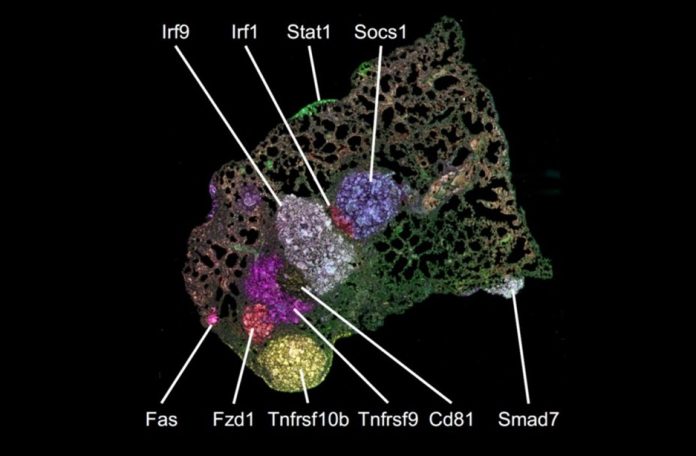A new spatial functional genomics technology developed by scientists at the Icahn School of Medicine at Mount Sinai, New York, makes it possible to discover genes that regulate cell-extrinsic functions at an unprecedented scale and at single-cell resolution. The technology called Perturb-map employs a genetic barcode to mark cancer cells, normal neighboring cells and components of the tumor microenvironment without removing them from the tissue, thereby preserving spatial architecture.
The authors apply their new platform to knock out different genes in parallel in a mouse model of lung cancer to understand their impact on the growth, cellular architecture, and immune composition of tumors. The team also combines Perturb-map and spatial transcriptomics to analyze CRISPR-edited tumors.
These findings were published on March 14, 2022, in the journal Cell, in an article titled “Spatial CRISPR genomics identifies regulators of the tumor microenvironment.”

Brian Brown, PhD, professor of genetics and genomic sciences at the Icahn School of Medicine at Mount Sinai and the senior author of the study said, “The paper establishes a new technology that is going to help accelerate the discovery of genes and gene functions that serve to control many different aspects of tumor biology, such as tumor morphology, metastasis, and immunity. For the cancer immunology field, and for the tumor microenvironment field, there are lots of genetic screens that will be made possible that weren’t before.”
Probing beyond the cell
Brown’s team was inspired by the need to identify genes that control extracellular processes that protect cancer cells which cannot be probed well through existing CRISPR screens that are best suited to study processes within cells such as genetic mechanisms of cell proliferation, protein expression, and drug resistance.
Brown said, “The spatial information is lost in these [pooled CRISPR] screens. If a particular gene knockout altered the local environment of the cell, for example by changing the vasculature or recruiting more T cells, this information is lost because we never see what was outside the cancer cells.”
The Perturb-map platform images cancer cells and normal cells in and around the tumor, as well as extracellular molecules like mucins. “We are also able to screen entire classes of genes, for example cytokines, chemokines, etc., that can’t be screened with existing pooled screens because they operate outside the cell. This is because we don’t have to disrupt the cells from their environment to study how a particular gene knockout altered its local environment,” Brown explained.
A new barcode
Perturb-map detects CRISPR-mediated gene knockouts in tissues using Pro-Code technology that was developed in Brown’s lab and published in a 2018 Cell paper. The platform uses multiplex imaging where tissues are stained with antibodies that detect the barcodes called ‘Pro-Codes’.
“We used Pro-Codes to mark cells carrying different CRISPR guide RNAs. We adopted multiplex imaging techniques—which enable >10 different proteins to be detected on a single tissue section with single-cell resolution—to detect 120 Pro-Code expressing cancer cells,” Brown said.
This approach allows the spatial resolution of hundreds of tumor lesions with different gene knockouts in situ. Combined with spatial transcriptomics the platform can determine the molecular state of tumor lesions with different gene knockouts.
For the current study, the investigators created a new set of Pro-Codes with a different scaffold protein that is not membrane-bound but moves into the nucleus. New Pro-Codes together with a digital pipeline for registering images and segmenting cells, upgraded image analysis in this study.

Lung tumor immunity
Through the application of Perturb-map in animal models, the researchers uncovered insights into lung tumor immunity that could help develop new immunotherapies. Specifically, the authors found loss of SOC1 increased the growth of lung tumors, accompanied by a paradoxical increase in the infiltration of T cells into tumors. They resolved the conundrum by probing further to uncover that SOCS1 knockout leads to a simultaneous increase in PD-L1 on cancer cells that incapacitates T cells that enter the tumor.
“When we treated SOCS1 knockout tumors with a drug that blocks PD-L1, the tumors shrank more than controls,” said Brown. This mechanistic insight could pave the way for pairing PD1/PDL1 blockade with SOCS1 inhibition as a more effective immunotherapeutic strategy.
In parallel experiments, the investigators found loss of the receptor of a multifunctional cytokine called ‘transforming growth factor beta’ on cancer cells, changed the tumor microenvironment into a slimy mucus-filled pool dotted with fibrous cells that prevented the entry of T cells. The genetic perturbation indicated loss of the Tgfbr2 receptor increased the availability of the cytokine that suppresses immune response in the tumor microenvironment.
Next steps
In future studies, Brown’s team intends to diversify to probe tumor immunity in other types of cancers including ovarian, pancreatic and breast cancer. In these different tumors, the focus of the team continues to be understanding the genes that tumors use to subvert the immune system. In addition to probing into cancer cells, the team is applying Perturb-map to study genes that control the biology of immune cells.
Brown’s team has deposited the Pro-Code constructs at Addgene to make them widely available. “We’re looking forward to what others will do with the technology,” said Brown.
Applications of this new platform could accelerate the discovery of new targets for better cancer therapies.


